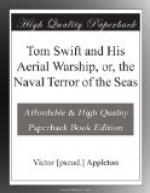“No, it certainly is not,” agreed Lieutenant Marbury, “and I am interested in seeing how you will overcome the recoil.”
“We’ll have a test soon,” announced Tom.
Meanwhile the Mars, having reached a considerable height, being up so far, in fact, that the village of Shopton could scarcely be distinguished, Tom set the signal that told the engine-room force to start the propellers. This would send them ahead.
Some of Tom’s most trusted workmen formed the operating crew, the young inventor taking charge of the pilot-house himself.
“Well she seems to run all right,” observed Lieutenant Marbury, as the big craft surged ahead just below a stratum of white, fleecy clouds.
“Yes, but not as fast as I’d like to see her go,” Tom replied. “Of course the machinery is new, and it will take some little time for it to wear down smooth. I’ll speed her up a little now.”
They had been running for perhaps ten minutes when Tom shoved over the hand of an indicator that communicated with the engine-room from the pilot-house. At once the Mars increased her speed.
“She can do it!” cried Ned.
“Bless my-hat! I should say so!” cried Mr. Damon, for he was standing outside the pilot-house just then, on the “bridge,” and the sudden increase of speed lifted his hat from his head.
“There you are—caught on the fly!” cried Ned, as he put up his hand just in time to catch the article in question.
“Thanks! Guess I’d better tie it fast,” remarked the odd man, putting his hat on tightly.
The aerial warship was put through several evolutions to test her stability, and to each one she responded well, earning the praise of the government officer. Up and down, to one side and the other, around in big circles, and even reversing, Tom sent his craft with a true hand and eye. In a speed test fifty-five miles was registered against a slight wind, and the young inventor said he knew he could do better than that as soon as some of the machinery was running more smoothly.
“And now suppose we get ready for the gun tests,” suggested Tom, when they had been running for about an hour.
“That’s what I’m mostly interested in,” said Lieutenant Marbury. “It’s easy enough to get several good types of dirigible balloons, but few of them will stand having a gun fired from them, to say nothing of several guns.”
“Well, I’m not making any rash promises,” Tom went on, “but I think we can turn the trick.”
The armament of the Mars was located around the center cabin. There were two large guns, fore and aft, throwing a four-inch projectile, and two smaller calibered quick-firers on either beam. The guns were mounted on pedestals that enabled the weapons to fire in almost any direction, save straight up, and of course the balloon bag being above them prevented this. However, there was an arrangement whereby a small automatic quick-firer could be sent up to a platform built on top of the gas envelope itself, and a man stationed there could shoot at a rival airship directly overhead.




